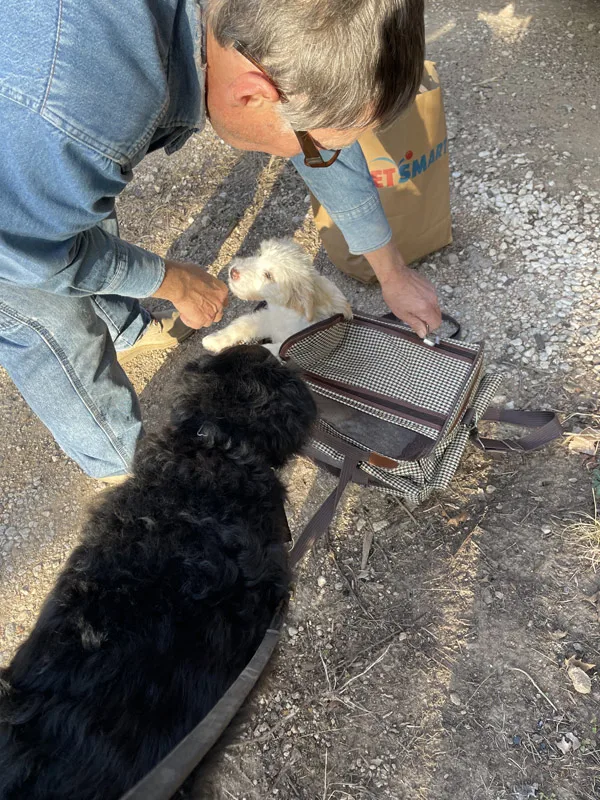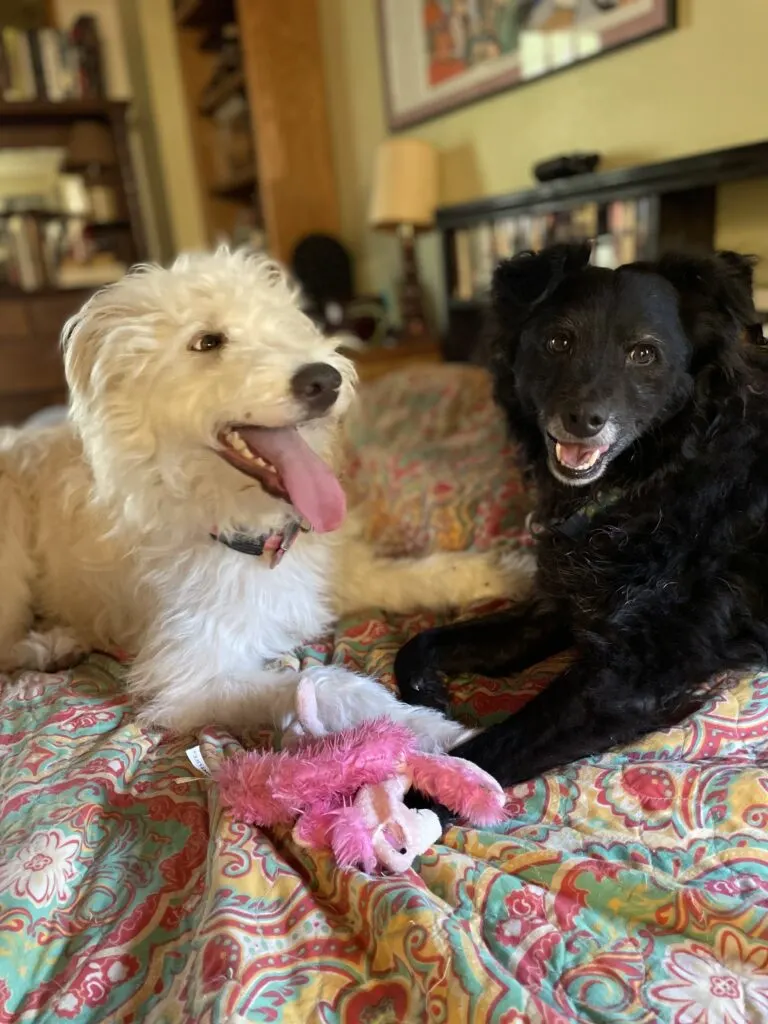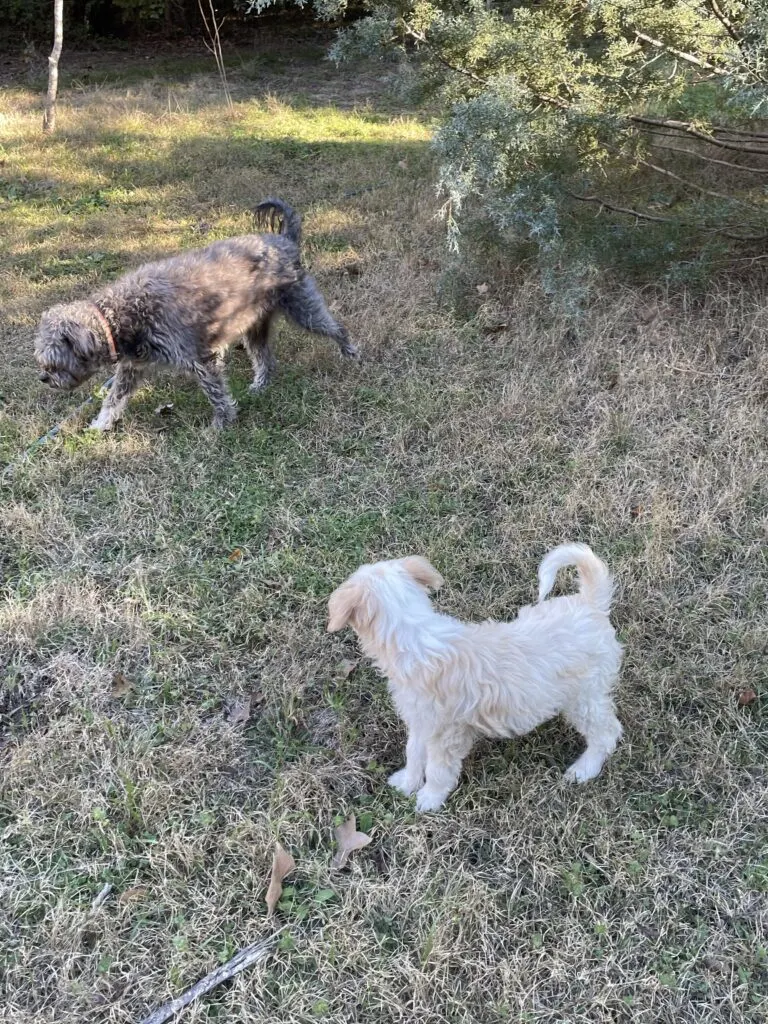So, you’re curious about Aussiedoodles and their ability to play nice with other dogs? Great choice! Aussiedoodles, those adorable mixtures of Australian Shepherd and Poodle, are known for their lovable and friendly nature. But how do they fare when it comes to interacting with other furry friends? Let’s dive into the world of Aussiedoodle social behavior and I’ll tell you about our personal experience with our Aussiedoodle, Isla, and our Border Collie mix, Barli!

Aussiedoodle Temperament
First off, let’s look at what Aussiedoodles inherit from their parent breeds. Australian Shepherds are known for their loyalty and energy, while Poodles bring intelligence and playfulness to the mix.
This combination often results in an Aussiedoodle that’s both smart and sociable. However, keep in mind that every dog is unique, so there’s a range of personalities within the breed.
When I went to the shelter to look for a companion for our five-year-old Barli, I was looking for a female puppy since he is a male. As they say, opposites attract, and you’ll often have the best luck with a male and female, rather than two males or (most especially) two females.

I was also looking for an outgoing dog who was confident. Barli is an extremely shy dog and has always had a more confident dog to look up to in new situations. I spent a lot of time at the shelter meeting dogs and puppies, temperament testing and making a decision that wasn’t just best for us but was also best for Barli.
Aussiedoodles in Multi-Dog Households
Are you also thinking of bringing an Aussiedoodle into a home with another dog? Many Aussiedoodles thrive in multi-dog households. The key is proper introduction and supervision, especially in the beginning, to ensure everyone gets along.
Introducing your new Aussiedoodle to an older dog in your household can be a pivotal moment, and it can set the tone for their future relationship–so plan it out!
Start by choosing neutral ground for their first meeting. This helps prevent your older dog from feeling territorial, which can happen if the introduction occurs at home or in your yard. Before the meeting, ensure both dogs have had a chance to exercise. A tired dog is generally more relaxed and less likely to exhibit aggressive or overly dominant behavior.
We introduced Barli to Isla outside the yard. She was in a soft-sided carrier so we let Barli come up to sniff the carrier before showing him the puppy.

During the initial introduction to the puppy, keep your older dog on leash, but allow him some slack to move freely. If you’re adopting an older Aussiedoodle, keep him on leash as well.
For two dogs past the puppy stage, one the best ways to meet each other is on a walk, just coming up and greeting then continuing their walk together. Walking a slight distance apart gives each dog some space and walking together is a natural bonding experience for dogs.
Observe your dogs’ body language closely. Signs of relaxation, such as a wagging tail or playful posture, are positive indicators!
If either dog shows signs of stress or aggression—like growling, stiff body language, or bared teeth—it’s time to calmly separate them and try again later.
It’s important not to rush this process. Some dogs may warm up to each other immediately, while others might need several meetings to get comfortable.
Once they seem at ease around each other, you can bring them into your home. In the home, create separate spaces for each dog. Your older dog should have his own area, where he can retreat to feel safe and relaxed.
The puppy should have its own space too, equipped with a bed, toys, and water. Most puppies will have a crate or exercise pen to keep them confined and safe from household hazards.
Over time, you can allow them to spend more time together under supervision, gradually increasing their interactions as they become more comfortable with one another.
Remember, patience and positive reinforcement are key. Offer plenty of praise and treats when they interact well to reinforce good behavior. With time and patience, your puppy and older dog can develop a harmonious and affectionate relationship. Isla and Barli are best buddies now!

Meeting Other Dogs
Will your Aussiedoodle like other dogs not in your household? Remember, early socialization is key. Exposing your Aussiedoodle puppy to different dogs, people, and environments can make a world of difference in how they interact with others.
Puppy classes with other vaccinated puppies can be fantastic ways to encourage positive social skills. I took our Isla to puppy class about a month after adoption; they helped her learn to greet other people and other dogs (and helped burn up some of that puppy energy every week!)
If you have friends and family members whose dogs you know are fully vaccinated, you can also let your puppy meet those.

When Isla was with us for about a week, our neighbor brought over his dog Buddy for a meet and greet. Their first meeting was short as Isla’s puppy energy was a little much for older Buddy–but within a few weeks they soon discovered their shared love of fetch!
Aussiedoodles are often bundles of joy and energy. They love to play, which usually makes them great companions for other dogs who share their enthusiasm.
Regular playtimes and exercise are essential to keep them happy and healthy.
Herding Instincts and Interaction
Thanks to their Australian Shepherd heritage, some Aussiedoodles may have a natural herding instinct.
This doesn’t mean they’ll try to herd your neighbor’s kids, but they might gently herd other pets. We have had this issue with Isla and our cats; we had to keep a close eye on her the first several months when interacting with our cats (and always offering the cats an escape from her to higher ground in the room). We redirected Isla to other activities, and she has learned that she needs to be in a calm state to play with the cats.
Understanding and managing this trait can ensure it doesn’t turn into overbearing behavior during play.
Training and Behavior Management
Training and socialization plays a big part in fostering good doggy social skills. Basic commands, obedience training, and learning to read your dog’s cues are vital.
Although we couldn’t let Isla play with other dogs whose vaccine status we didn’t know until her own vaccines were completed, we took her to the park in a backpack carrier to help socialize her and let her see other dogs at a distance.
Individual Differences and Personality
It’s important to remember that Aussiedoodles, like people, have their own personalities! Some may be outgoing social butterflies when it comes to other dogs, while others might be a bit more reserved. Respect your dog’s comfort zone and don’t force interactions if they seem uncomfortable.
Warning Signs and Intervention
Keep an eye out for signs of discomfort or aggression in your Aussiedoodle when they’re around other dogs. Growling, hair standing up on their back, or a tucked tail can be signs of distress. If you see these, it’s time to step in and give your pup a break.
To sum it up, Aussiedoodles often make fantastic friends for other dogs, thanks to their friendly and playful nature. With the right socialization, training, and a bit of understanding of their unique traits, your Aussiedoodle can be the life of the dog park. Remember, every dog is an individual, so embrace your Aussiedoodle’s unique personality and enjoy the wonderful journey of pet parenthood!
More Aussiedoodle Questions
Do Aussiedoodles Have a Double Coat or Single Coat?
Are Aussiedoodles Loyal to One Person?
- What’s an Unfurnished Aussiedoodle? - December 14, 2024
- 500+ Aussiedoodle Names - July 29, 2024
- Does Your Breeder Do Puppy Socialization? - July 9, 2024
